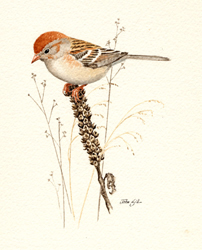Breeding Bird Atlases (BBA)
Find a Bird - BBA1
Breeding Bird Atlas 1 Species Accounts
Field Sparrow
Spizella pusilla
Egg Dates
May 8 to August 13
Number of Broods
one or two; possibly three; may re-lay if first attempt fails

The Field Sparrow is a fairly common breeding species throughout much of the state. However, because its nesting ecology is closely associated with old field habitat, the Field Sparrow has a population that is on the decline in Massachusetts. During the latter half of the nineteenth century, midwestern and prairie farmlands offered favorable alternatives to the rocky New England soils, and many Massachusetts agricultural ventures were abandoned. The earlier clearing and subsequent second growth provided prime habitat for the Field Sparrow.
As these open, brushy areas have gradually given way to both reforestation and suburban development, optimal nesting areas for this species have been greatly reduced. A few human-made clearings, such as those associated with power lines through wooded areas, provide suitable nesting sites for the Field Sparrow. However, suburban development has not offered the same advantages to this species as it has to its congener, the Chipping Sparrow.
In the spring, Field Sparrow migrants and returning residents move into our area during the month of April. Territorial males are often heard and seen around abandoned pastures and other unworked rural farmlands. Fields containing some briers and shrub growth make ideal nesting habitat. In wooded regions, open areas that have been cleared or burned also provide nesting territory. The males chase one another and may fight before boundary lines are settled. As is the case with the robin, there may be neutral zones where several pairs will feed without conflict. When the female arrives about two weeks later, the male chases her somewhat aggressively at first, but this soon ceases and he then follows her closely as she moves about the territory.
The Field Sparrow’s song begins with several slurred whistles, quickens to a series of rapid notes, and fades off at the end. This has been variously represented as t-e-w, t-e-w, t-e-w, tew, tew tew, tew or seeea, seeea, wee, wee, we, we, we. The rhythm is much like that of a Ping-Pong ball bouncing on a table. Once heard, the evocative song is unforgettable. There are a variety of other notes. A zee-zee or tsee-tsee series and a longer zeeeeeeee are used as warnings. Males use a zip-zip-zip call to attract females, and a loud chip is given by begging fledglings or alarmed adults. A common contact note is a soft tsip.
The earliest nests of the season normally will be constructed on the ground in a clump of grass. As the season progresses, the female is more likely to build a nest in shrubs or briers. Six nests in Massachusetts were located as follows: 1 on the ground in grass in a dry field, 1 on the ground in grass in a damp meadow, 1 close to the ground in goldenrod stalks, 1 near the ground in a shrub, 1 at 1.7 feet above the ground in Multiflora Rose, and 1 at 1.3 feet in Meadowsweet (CNR, Meservey). The meadow nest was completely covered over with both dry and green grass stalks and had a side entrance that was also roofed over (Meservey). The cup-shaped nest of the Field Sparrow is loosely constructed of grasses and twigs and is often lined with hair or other fine materials. Three to four eggs are usual. Clutch sizes for 9 state nests were three eggs (2 nests), four eggs (6 nests), five eggs (1 nest) (CNR, DKW, Meservey).
Incubation by the female lasts 11 to 14 days, sometimes longer. The nestlings are brooded for the first several days, and the young are fed insects by both parents. Brood sizes for 3 state nests were four young each (CNR). The young leave the nest approximately a week after hatching, but it is almost another week before they are capable of short, fluttering flights. Juveniles continue to receive some food from their parents until they are 26 to 34 days old.
If the female begins a new nest, the care of the fledglings falls to the male. A pair will often raise two broods per season, and any predation or interference by cowbirds may result in repeated renesting. Three broods have been documented in some areas but not for Massachusetts. The young birds often remain together on or close by their home territory for the remainder of the season. Adults and young complete their molts by the end of the summer.
Nestlings have been reported in Massachusetts from June 11 to August 13, the latter being a hatch date for a nest in Pelham. Hatching in a Pittsfield nest occurred about June 27 (Nice 1933, CNR). Fledged young have been recorded in the state from June 8 to August 9 (CNR, Nice 1933, Meservey). The protracted period for egg dates indicates that the range for both nestlings and fledglings is undoubtedly greater than those provided here.
During the period from late September through late October, small flocks of migrant Field Sparrows can be found in weedy fields, along roadsides, and in waste places. By mid-November, most of the population has moved out of our area to wintering grounds in the southern United States. Some Field Sparrows winter in Massachusetts each year, and small flocks of overwintering birds are occasionally encountered in weedy habitats, especially in southeastern coastal areas.
Map Legend and Data Summary
Atlas 1 data collected from 1975-1979


Note: uncommon to fairly common in overgrown pastures, fields, and woodland edges throughout the state
Richard K. Walton



